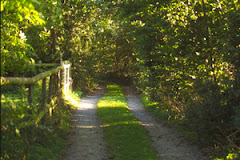
Now the leaves have all gone here's a little reminder of the summer that never was...
"The Dingle / Nant y Pandy Local Nature reserve is a 10 hectare (25 acre) wooded valley, rich in wildlife and history. It has recently been enhanced through community involvement, working in partnership, and by grant aid.
These enhancements include a wooden boardwalk that winds its way along the Cefni, which allows access to all to many parts of the reserve, three new bridges, sculptures, sculpted benches and picnic tables.
The sculptures include a huge dragonfly, giant seed pods and split oak timbers revealing the poem Nant y Pandy, by local poet Rolant o Fôn.
Parts of the woodland are dominated by sessile oak, ash and wild cherry, with a spectacular show of blue bells in spring. Other parts are mostly sycamore and the occasional ash tree with an abundance of ferns and mosses and woodland flowers, such as wood anemones. Coed Plas (behind Saint Cyngar's Church) was planted with sweet chestnut, beech and Scots pine, and has a carpet of wild daffodils in spring.
Frogs and newts live in the wetter areas, and adders and lizards in the drier woodland. There are many butterfly species, such as gatekeeper and the speckled wood, as well as moths. There are also dragonflies and damselflies, hoverflies, bees and wasps, beetles, slugs and snails, spiders, woodlice, and many other small creatures.
Birds are easy to see throughout the year; blue tits and great tits nest in the woods and moorhen in the water; wrens and grey wagtails are common small birds seen along the boardwalk; and larger birds, ravens, buzzards and herons fly overhead. A glimpse of a kingfisher may be seen as a flash of electric blue, or a dipper may be bobbing along the river. The tawny owl can be heard, and often seen, in the woodland at night.
Fish like the trout, roach and perch may be seen in Llyn Pwmp, and sea trout are occasional visitors, as are eels.























47.jpg)
